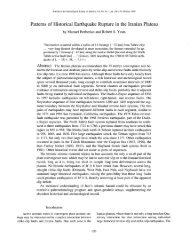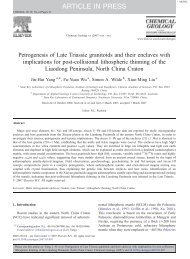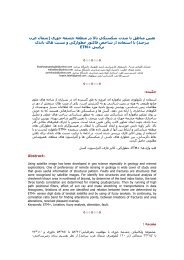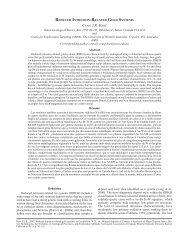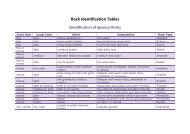Subevent analysis for the Tabas earthquake of September 16, 1978 ...
Subevent analysis for the Tabas earthquake of September 16, 1978 ...
Subevent analysis for the Tabas earthquake of September 16, 1978 ...
You also want an ePaper? Increase the reach of your titles
YUMPU automatically turns print PDFs into web optimized ePapers that Google loves.
20 I. Sarkar et al. / Physics <strong>of</strong> <strong>the</strong> Earth and Planetary Interiors xxx (2005) xxx–xxx<br />
wave arrival time is <strong>of</strong> <strong>the</strong> order <strong>of</strong> 20.0 s. For a rupture<br />
velocity <strong>of</strong> 2.7 ± 2 km/s and a hypocentral distance <strong>of</strong><br />
30 km (estimated from <strong>the</strong> best-fit Brune ω −2 model<br />
spectrum), this suggests that possibly S4 phase <strong>of</strong> energy<br />
was released approximately <strong>16</strong>.8 ± 0.8 s after <strong>the</strong><br />
release <strong>of</strong> S2 phase <strong>of</strong> energy.<br />
The various <strong>analysis</strong> <strong>of</strong> <strong>the</strong> <strong>Tabas</strong> <strong>earthquake</strong> fault,<br />
based on a single point source representation and teleseismic<br />
data, obtains strike, dip and slip <strong>of</strong> around 332 ◦ ,<br />
30 ◦ and 110 ◦ , respectively (Berbarian et al., (1979);<br />
Niazi and Kanamori, (1981) and CMT solution). However,<br />
Walker et al., (2003) used regional and teleseismic<br />
data jointly to obtain strike, dip and slip <strong>of</strong> around<br />
355 ◦ ,<strong>16</strong> ◦ and 155 ◦ , respectively. In our study, we have<br />
estimated <strong>the</strong> strike, dip and slip <strong>for</strong> <strong>the</strong> two larger subevents<br />
(S2 and S3) to be approximately 110 ◦ ,83 ◦ and<br />
75 ◦ , respectively, which are in closer con<strong>for</strong>mity to <strong>the</strong><br />
estimates given by Berbarian et al., (1979), Niazi and<br />
Kanamori, (1981) and CMT solution. Also our estimated<br />
strikes <strong>of</strong> <strong>the</strong> fault planes <strong>of</strong> <strong>the</strong>se two sub-events<br />
are sub-parallel to <strong>the</strong> regional strike <strong>of</strong> exposed faults<br />
in <strong>the</strong> area. We note that <strong>the</strong> alternate nodal planes have<br />
strikes in a nearly N–S direction.<br />
In inversion procedures based on teleseismic data,<br />
<strong>the</strong> <strong>earthquake</strong> has been modeled as a point source and<br />
with a single simple rupture process. Hence <strong>the</strong> ensuing<br />
results provide a model <strong>for</strong> <strong>the</strong> overall slip on <strong>the</strong> <strong>Tabas</strong><br />
causative fault. On <strong>the</strong> o<strong>the</strong>r hand, <strong>analysis</strong> <strong>of</strong> near field,<br />
high frequency and higher near source spatial coverage<br />
data provide detailed in<strong>for</strong>mation on <strong>the</strong> roughness <strong>of</strong><br />
<strong>the</strong> failure process over <strong>the</strong> fault plane by highlighting<br />
<strong>the</strong> jittering effects in <strong>the</strong> total slip process related to<br />
asperity failure. In this study several asperities on <strong>the</strong><br />
causative fault have been identified. Inversion <strong>of</strong> near<br />
field data and assuming a double couple source model<br />
shows that <strong>the</strong> (preferred) fault planes <strong>of</strong> <strong>the</strong> two larger<br />
asperities are both steeply dipping (dip = 83 ◦ ), generally<br />
oriented ESE–WNW (strike = 110 ◦ and 107 ◦ )<br />
and exhibit similar predominantly reverse thrust motion<br />
along with prominent left-lateral strike slip component<br />
(slip = 75.0 ◦ ). We have earlier surmised that <strong>the</strong><br />
asperities corresponding to <strong>the</strong> two/three o<strong>the</strong>r smaller<br />
sub-events also have similar orientation and slip direction.<br />
Our <strong>analysis</strong> <strong>of</strong> <strong>the</strong> predominantly high frequency<br />
(0.2 Hz < f < 6.0 Hz), near field data has thus provided<br />
detailed in<strong>for</strong>mation about <strong>the</strong> different aspects <strong>of</strong> <strong>the</strong><br />
complex rupture process that occurred in different sections<br />
<strong>of</strong> <strong>the</strong> <strong>Tabas</strong> thrust fault system. It is surmised<br />
that during <strong>the</strong> <strong>Tabas</strong> rupture process several subevents<br />
occurred at shallow depths, on steeply dipping<br />
ESE–WNW striking sub-faults, due to reverse thrust<br />
faulting along with some major strike slip component.<br />
These results are consistent with <strong>the</strong> complex geological<br />
structure <strong>of</strong> <strong>the</strong> area that is demonstrated by <strong>the</strong><br />
series <strong>of</strong> exposed traces <strong>of</strong> faults that are <strong>of</strong>ten <strong>of</strong>fset at<br />
a number <strong>of</strong> places. Also we may note here Berbarian<br />
(1982)’s remarks on <strong>the</strong> basis <strong>of</strong> a detailed <strong>analysis</strong> <strong>of</strong><br />
some major aftershock sequences <strong>of</strong> <strong>the</strong> <strong>Tabas</strong> <strong>earthquake</strong><br />
that “The most striking feature <strong>of</strong> this faulting<br />
is that apparently several listric thrust planes were involved.”<br />
Because <strong>of</strong> <strong>the</strong> noise and deficiency <strong>of</strong> low frequency<br />
components in <strong>the</strong> data, <strong>the</strong>re is some scatter<br />
in our estimated M 0 <strong>for</strong> <strong>the</strong> different sub-events. However,<br />
considering (i) <strong>the</strong> reported seismic moment (M 0 )<br />
and moment magnitude (M w ) <strong>of</strong> <strong>the</strong> <strong>Tabas</strong> event viz.<br />
M 0 = 1.32 × 10 20 N m and M w = 7.4 and (ii) our estimated<br />
seismic moments and moment magnitudes <strong>of</strong> <strong>the</strong><br />
five sub-events (see Table 2), we note that <strong>the</strong> total seismic<br />
energy released during <strong>the</strong> entire <strong>earthquake</strong> process<br />
is equivalent to that released during <strong>the</strong> occurrence<br />
<strong>of</strong> <strong>the</strong>se five more significant sub-events in totality.<br />
Also note in Table 2 that our empirical estimates <strong>of</strong> <strong>the</strong><br />
shear wave energy radiated by <strong>the</strong> different sub-events<br />
are generally higher than those estimated directly from<br />
seismograms by Shoja-Taheri and Anderson (1988).<br />
Also while <strong>the</strong>ir energy estimates at Deyhook are suggested<br />
to be equal, our estimates are varied. Fur<strong>the</strong>r<br />
our values are on a higher side than those predicted by<br />
<strong>the</strong> well-known relation log E = 11.8 + 1.5M w . Our estimates<br />
<strong>of</strong> <strong>the</strong> stress that caused <strong>the</strong> seismic radiation<br />
during most <strong>of</strong> <strong>the</strong> sub-events (presumably <strong>the</strong> apparent<br />
stress drop) are generally less than 30 bar. However <strong>for</strong><br />
S2 sub-event, <strong>the</strong> main energy released is very high, <strong>of</strong><br />
<strong>the</strong> order <strong>of</strong> 100 bar at Deyhook and <strong>Tabas</strong>. Of course<br />
<strong>the</strong> Brune model estimate <strong>for</strong> <strong>the</strong> stress drop has <strong>of</strong>ten<br />
been found to be unstable, especially in case <strong>of</strong> complex<br />
rupture processes (<strong>for</strong> example, see Snoke, 1987).<br />
However, we suggest that in <strong>the</strong> region surrounding<br />
<strong>the</strong> S2 asperity, on <strong>the</strong> heterogeneous causative<br />
fault plane, where fracture was initially resisted, <strong>the</strong>re<br />
was possibly a large increase <strong>of</strong> dynamic stress that<br />
eventually caused breakage <strong>of</strong> this strong patch and,<br />
as a result, a localized extremely high stress drop<br />
occurred.



